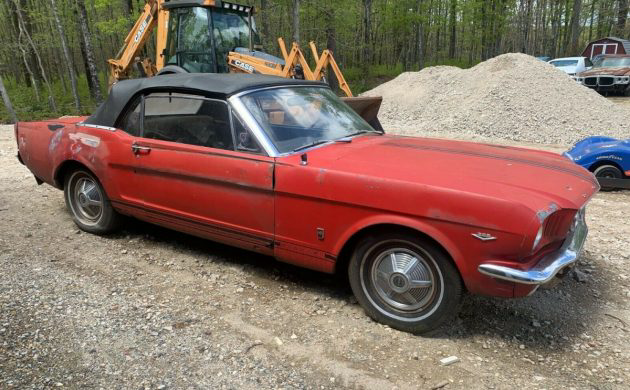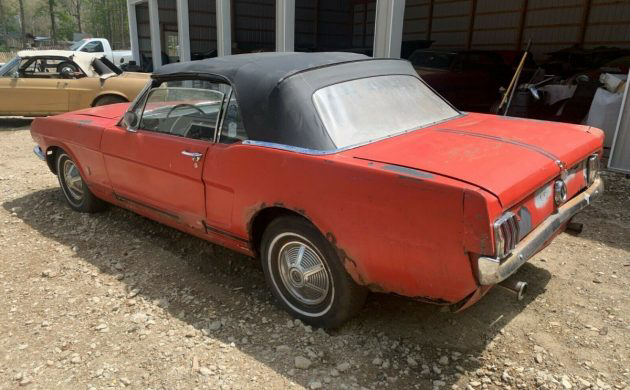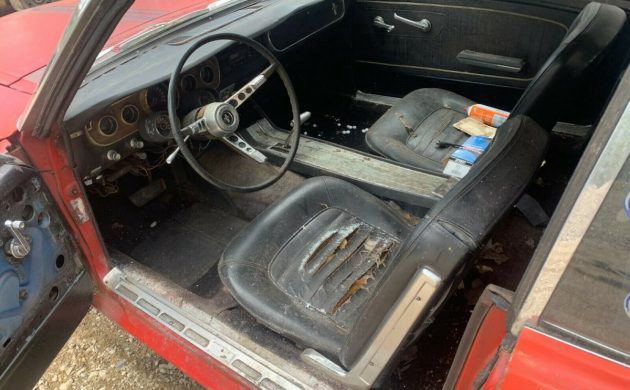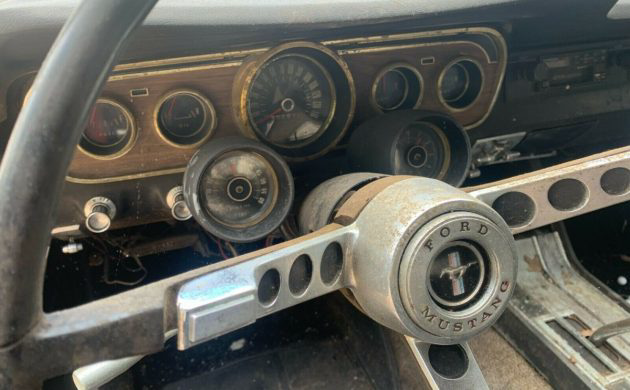It seems that the supply of great classic finds is not likely to dry up in the near future, and this 1965 Ford Mustang GT Convertible confirms that. The owner found the classic pony car languishing in an overhang beside a house and is looking for a buyer willing to return it to its former glory. The GT appears to be complete, and while it will need some work, it doesn’t look like it has deteriorated beyond the point of no return. Located in Manahawkin, New Jersey, you will find the Mustang listed for sale here on eBay. Bidding has reached $7,655, and this has taken it past the reserve. That means that the highest bidder is set to take this one home. I have to say a big thank you to Barn Finder Larry D for spotting the Mustang for us.
The first thing to note with this Rangoon Red Mustang is that it does appear to be essentially complete. A few minor parts are missing, but there’s nothing that will delay the restoration or add significantly to the overall cost. It is a 1st Generation Mustang that has spent time exposed to the elements, which means that there will be rust for the buyer to tackle. It is in all of the usual spots, like the rear quarter panels and lower door corners, but the lower front fenders and rockers look surprisingly good. When we delve below the surface, the buyer will need to invest in floors and a trunk pan, while there might also be some rust in the torque box region. A rear bumper and some of the trim will probably need to go onto a shopping list, but the front bumper and distinctive GT grille and lights appear to be in a restorable state. The surprise is the soft-top. The rear window is as cloudy as you would expect, but the top itself looks remarkably good. I think that some careful cleaning and conditioning may have this item presenting acceptably for a driver-grade restoration.
Apart from the driver’s door trim, the Mustang’s interior appears to be complete. That’s not to say that it will present well with a quick vacuum and some cleaning because it will need plenty of restoration work. There’s nothing here that a trim kit wouldn’t help, and that will be the most cost-effective approach for the buyer to take. That is one of the strengths of 1st Generation Mustangs as project cars. They remain in high demand, and Ford produced them in significant quantities. That means that an entire industry has grown up around making affordable reproduction parts. It is possible to find some high-quality kits for around $1,000 and provided some of the existing hardware like handles can be reused, they represent a cheap way to have the interior looking factory-fresh.
The buyer will receive a couple of great optional extras when they hand over the cash for this Mustang. They include a factory console and the oh-so-cool Rally Pac gauges. Reproductions of both items are available, but there’s nothing quite like having the real thing. Thankfully, both of these items are not only intact, but they appear to be restorable. That’s a great piece of news for anyone contemplating this project build.
The GT appears to be mechanically complete, but it isn’t clear whether it is numbers-matching. The VIN indicates that this is an A-Code 289ci V8 that is backed by a 3-speed automatic transmission. The original owner also chose to order the Convertible with front disc brakes. The A-Code would have produced 225hp in its prime, which was sufficient to send the vehicle through the ¼ mile in 15.8 seconds. It isn’t clear when this 289 last roared into life, but it will undoubtedly require a spot of TLC before it does so once again. It does turn freely, and the owner believes that flushing the fuel system and rebuilding the carburetor should produce some reward. That won’t make it roadworthy, but it is a start. If the buyer is seeking a high-quality finish, they will probably pull the motor to get the engine bay up to scratch. That would represent the perfect opportunity to inspect that little V8 thoroughly and to detail it within an inch of its life.
First Generation Mustang project cars will always command interest when listed for sale, and this ’65 GT Convertible is no exception. It has already received 29 bids, and there’s still plenty of time left on the auction. This one looks to be no worse than any other project that we’ve seen over the years at Barn Finds, and restoring it could be a rewarding experience. With what you’ve seen, is this a classic on which you might be tempted to bid?








The plus is the parts are cheap fo Mustang with aftermarket parts. This will need many metal pieces.
Engine rebuild and paint.
Some one should pull the starter to get the numbers to check if 90 days from
Build date.
Good luck 🍀
67 stang vert owner that refurbished a rustang in the past…
If I was in the market for a Mustang to re-do this would be a prime candidate indeed. V-8 GT convert. Megaphone exhaust, auto, console, rally pack,disc brakes, it’s got it all. I would add A/C to make it perfect. Unfortunately I’m much to old to delve into this project (sigh).
‘ Can’t believe I’m the first to comment. ‘ Can’t believe that a Mustang in this condition has been bid already to five digits. It does look like a good project. If I were to buy a Mustang, this is something I’d look for. But I must be really naïve, because I’d expect to pay maybe $3500 tops for it.
Speaking of “tops” – I have a pet peeve with Fomoco: “GT Convertible” is an oxymoron. I guess we’ve travelled this road before: consider the 1950s advent of the “hardtop convertible”. A car cannot be both. In correct automotive terminology, a “tourer” is either a roadster (no side windows) or a convertible. A “grande tourer”(GT) is an enclosed car – a coupe.
Maybe I’m just picky as well as naïve in my old age…
‘ Can’t believe I’m the first to comment. (‘ Turns out I’m not.) ‘ Can’t believe that a Mustang in this condition has been bid already to five digits. It does look like a good project. If I were to buy a Mustang, this is something I’d look for. But I must be really naïve, because I’d expect to pay maybe $3500 tops for it.
Speaking of “tops” – I have a pet peeve with Fomoco: “GT Convertible” is an oxymoron. I guess we’ve travelled this road before: consider the 1950s advent of the “hardtop convertible”. A car cannot be both. In correct automotive terminology, a “tourer” is either a roadster (no side windows) or a convertible. A “grande tourer”(GT) is an enclosed car – a coupe.
Maybe I’m just picky as well as naïve in my old age…
I love the car! However, I wonder how much it would cost above the 10K already bid in order to get it in top condition? The car for sale in the link, https://classiccars.com/listings/view/1377063/1965-ford-mustang-gt-for-sale-in-hohokus-new-jersey-07423
is listed for 47K. Could you pump 37K more into this one and have a comparable car?
Keith, good question. If you farmed out the resto I’m sure it would be over 30k easily. One of the huge bugaboos of these convertibles is the inner rockers. These provide the longitudal strength to the unibody. Ford In its infiniiite wisdom, sent the drains for the convertible into the inner rockers, and most of them are gone. A sure sign that you have the disease is the doors wont close and are missaligned. Nope, adjusting the doors wont do it. From what I can see from the pics, these are gone. Doable but ugly job. I Bought a 65 falcon conv that needed both sides, spent a year fixing them. Good luck to whoever buys this rustang. Its over 10 large now. Know what you are buying. Parts readily available. Plenty of talented bodymen out there that can do the job.\
Cheers
GPC
Agree totally, I was into mine $5k until the rockers shut me down, you’re looking at an easy $25k to restore this-not worth $10k+
I hope this comment/question will post and actually stay up. I also hope that if it does that someone will answer. I hate to sound like such a newbie but I don’t understand exactly what a torque box is on these and it’s true function. I have Googled it and know what they look like but I didn’t find anything to really answer my question.
A torque box on an early Mustang is the triangular steel box that bridges the gap between the front inner frame rails and the inner rocker panel frame rails. Its purpose is to resist twisting forces and increase overall chassis rigidity.
David, I cannot fake it – I don’t know what a torque box is either. Don’t be embarrassed!
My concern is the cost and quality of the restoration. You don’t just take a car to a shop and say “restore it”. You have to know what you want – even if you’re having somebody else do all the work. Do you want a car to drive, or do you want a trailer queen that lives in a climate-controlled storage facility. If you’re after concours trophies, you will not be driving the car but spending $5-10,000 per year to have it professionally detailed.
At shows, once out of your enclosed climate-controlled trailer, on the show field, yes you will start it and drive it on the grass to its parking place on the field. You will demonstrate to the judges that everything works properly. If you’re lucky, you’ll receive your 2nd or 3rd place ribbon, put it back in the trailer and go home. The restoration itself will probably cost you $50-100,000.
If you want a stunning car to drive, the bill could still be in the $40,000 ballpark. Unless you’re an experienced concours participant, you will not see the compromises. You will have a car to enjoy, and maybe even drive on long-distance tours and rallys. If you want to maintain the condition, you can still figure on maybe a $5-6000 bill for detailing perhaps every couple of years.
Now, if you join me at the bottom of the collector-car food chain, you know how to use tools and you LOVE using them, you do as much of the work yourself as possible. You can buy a MIG welder for a heckuva lot less than it costs to hire a guy to use one for you. You have to love the research too. Sometimes it takes weeks of study before you actually know what you want, and have some idea of how to get there. It will take you longer – a lot longer. Whereas an attentive restoration shop might be able to deliver in 2-3, maybe 4 years, it will take you 7-8 on average, or more – much more. BUT you’ll love that time spent on your car. You’re doing what you enjoy doing. Through sweat equity, the longer it takes you, the cheaper your hobby becomes. It will still cost you big time. A really nice paint job, for example, uses several thousand dollars worth of material. Yes, I said “several thousand…” Don’t be surprised if, despite all your work, it still costs you $30,000 – at least a half of that being paint. That’s one thing I can’t do myself.
So, what do you get out of this process? First, you know exactly what you have. You won’t discover five years later that the resto shop patched your floor panels with pop-riveted expired registration plates – some of the most expensive ones known to man! You also have the incredible pride that comes with showing off your set of pictures: “before”, “during”, and “after”. The perks are absolutely HUGE!
If you want a $60-75,000 car, buy the one in NJ for $47,000. If that car is really a “no expense spared” restoration, it will prove to you that it’s ALWAYS cheaper to let somebody else do the restoration and then you buy the finished product from them. Have them show you receipts, and have an expert examine the car for you. If he’s really good, it will be worth the $500 spent. The point here is that (the cost of the car) + (the cost of restoration) ALWAYS = (> than market value). Much >!
I would say it’s a $35k + restoration. I have new OEM front fenders, hood, Complete headlight extensions and buckets still in factory primer. Hopping the frame rails torque boxes and floors are still solid.